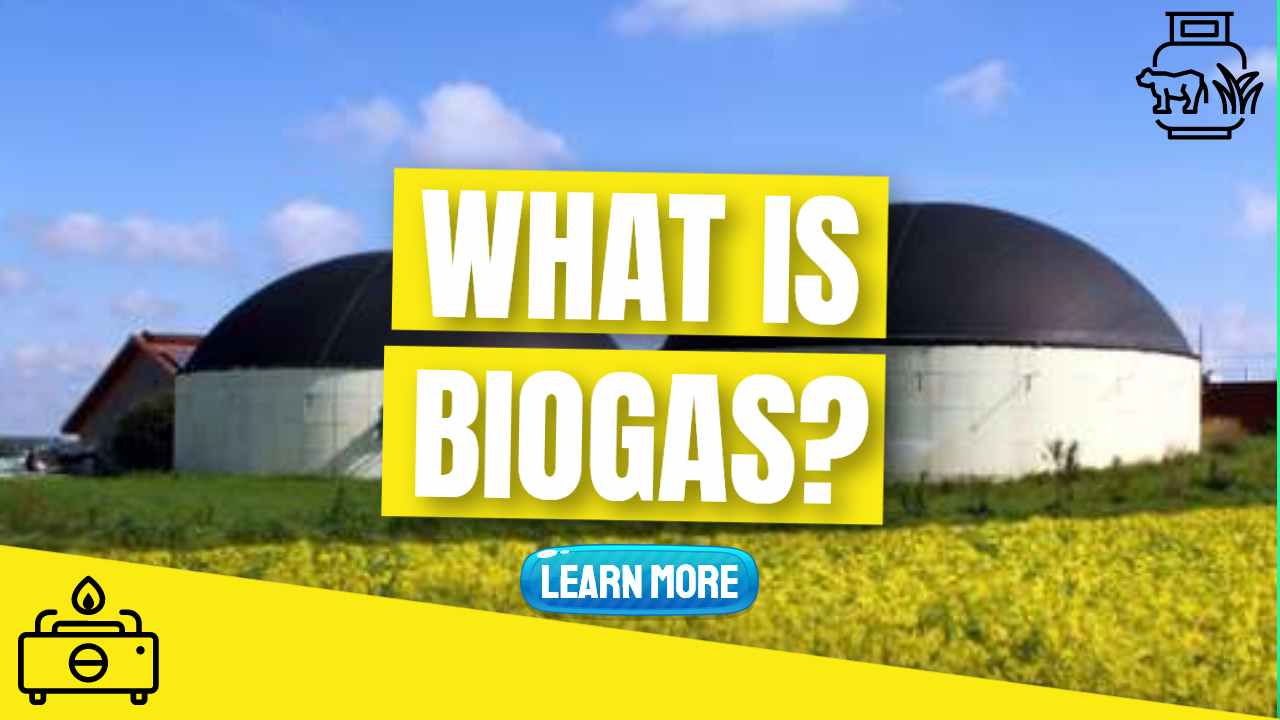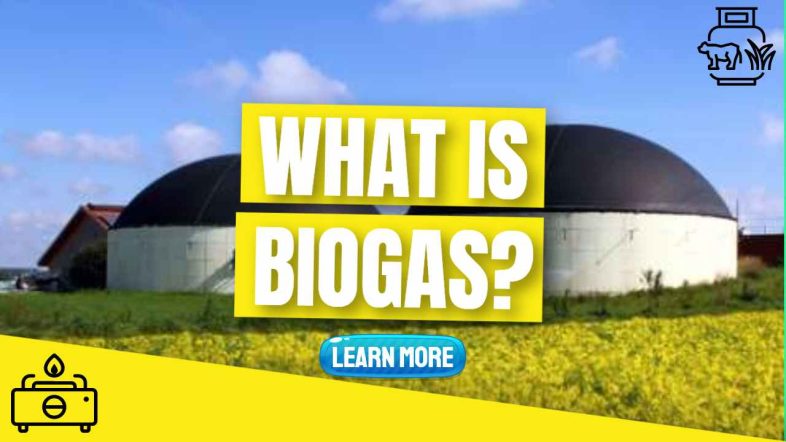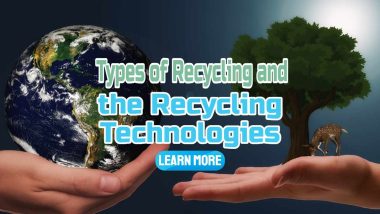The answer to the question, what is biogas?
This environmentally friendly fuel is derived from anaerobic digestion (without oxygen). This process occurs in the presence of organic matter. In some environments, this organic matter is disposed of as livestock waste. In other locations, it is a waste water. There are many benefits of biogas for industrial and residential applications. To learn more, read the following article. It will help you understand the process of harvesting biogas.
The Biogas Process
The process of creating biogas, also sometimes (often in India) known as biomethanation, is a multistep process. In a digester, two groups of microorganisms feed on the same feedstock and produce biologically derived gases. These microbes then break down the feedstock into methane and other gases, such as carbon dioxide and hydrogen sulphide (H2S). Some organic materials may also sulphur, depending on their composition and that provides a source for the high odour potential presence of H2S.
Other gases found in biogas
The process of anaerobic digestion produces carbon dioxide and methane. It also produces smaller amounts of water, particulates, and nitrogen. The resultant gases are used for various purposes, including direct combustion and fuel cells. In some cases, the methane is recycled back into the biogas recovery system. These methods can be used to generate clean, renewable fuels and to replace fossil fuels. A common method of using biogas is the recirculation of animal and food waste from farms and landfills.

Trace gases found in Biogas
The process of anaerobic digestion produces methane and carbon dioxide, in addition, to trace gases like nitrogen and oxygen. The gas can also be used as a fuel in fuel cells, direct combustion systems, or in a recirculation system for biogas. However, before it can be used, it must be processed. Several types of digesters exist. A small consumer digester is a good example of a small-scale digester.
Biogas, also known as renewable natural gas, is “renewable” in the sense that humans and animals will continue to generate waste – but we don't want to encourage people to generate more waste solely for the purpose of producing more biogas, as this would be harmful to the environment. After all, even if capturing and using methane is preferable to allowing it to escape into the atmosphere, the latter is preferable to the former.
Gains for the environment which the anaerobic digestion and the biogas produced provide
The process of biogas production (as “renewable” natural gas) has very important gains for the environment. Biogas contains methane, carbon dioxide, and trace elements. These gases can be converted to electricity or heat. The process of biogas production is a complex one. A well-functioning system will make energy from the raw material. It will help reduce greenhouse gas emissions while reducing waste. It is a renewable source of energy. The process is cost-effective and can be applied to a variety of industries.
Controlling the process of biogas production
The process of biogas production can be controlled by monitoring its composition and avoiding contaminants. The pH of the substrate varies between anaerobic conditions. The process is a natural way of producing energy. The end product is a biogas that is a blend of methane and carbon dioxide. It is not a waste product. The process is a renewable energy source that can be used for a variety of applications.
What sort of waste can be used to produce biogas?
Animal and plant wastes can be used to produce biogas for a variety of applications. Anaerobic digesters are used to process them, and they can be processed either as a liquid or as a slurry mixed with water. In general, anaerobic digesters consist of a feedstock source holder, a digestion tank, a biogas recovery unit, and heat exchangers to keep the temperature necessary for bacterial digestion at a constant level.
Biogas differs from natural gas in that it is a renewable energy source produced biologically through anaerobic digestion, as opposed to natural gas, which is a fossil fuel derived from geological processes.
Crushed and slurried biowaste is prepared for anaerobic digestion by crushing it into smaller pieces and blending it with water. Slurrying refers to the process of adding liquid to biowaste in order to make it easier to process. Microbes thrive in warm environments, which is why the biowaste is heated to approximately 37 degrees Celsius. T
Consumer scale or large-scale industrial systems
The process of biogas production can be done on a consumer scale or on a large-scale industrial scale. The process uses anaerobic bacteria. This process can be used in many different applications, and there are several types of biogas digesters. Most small consumer-scale systems are designed for the purpose of generating renewable energy to heat lamps and stoves. They are not intended for industrial purposes, but they can be a low-cost source of green energy.
Animal waste digestion systems on a small scale are most commonly used for this purpose. Modern family-size systems, on the other hand, are designed to digest food waste. The biogas produced can be used in a variety of applications including gas, electricity, heat, and transportation fuels. Examples include hundreds of cars and buses that run on refined biogas in Sweden, among other places. In Sweden, biogas is primarily produced by sewage treatment plants and landfills, according to the Environmental Protection Agency.
Biogas From Organic Waste – Not Food Crops
Biogas is always normally produced from organic waste. It is an eco-friendly fuel and is an excellent source of energy. As the process of biogas production involves the use of organic waste, it is a great option for both commercial and residential applications. It is cheap, eco-friendly, and can be used in homes and businesses. This is especially useful for farmers as it can be used as an inexpensive and efficient source of fertilizer. It can be produced from a wide variety of sources.
Biogas has risen in popularity in recent years as a “greener” alternative to fossil fuels. When anaerobic digestion breaks down organic matter, such as in landfills or “digesters” that convert animal manure or food waste, methane is produced.
This methane can be used to replace conventional natural gas in certain applications. Is it, however, a genuine renewable energy solution? You may not be surprised to learn that the situation is complicated. Comparing biogas to virgin natural gas obtained by drilling into the earth, it becomes clear that it is a more environmentally friendly option.
The breakdown of organic matter in a digester
Biogas is a byproduct of anaerobic digestion. It is made from the breakdown of organic matter in a digester. The result is a mixture of methane, carbon dioxide, hydrogen, and water vapour. The mixture contains trace amounts of other gases. Biogas is a renewable form of natural gas. The process of biogas production can be a renewable fuel and used for other applications. It can also be used in the transportation industry as an alternative to natural gas.
Animals, as well, can produce biogas too, especially methane.
When compared to carbon dioxide, methane gas has approximately 80 times the heat-trapping capabilities. Put another way, the environment will be less affected by a rotting loaf of bread converting to biogas than it would be if the loaf was simply left to rot in a landfill for a period of time.
Biogas CHP (Combined Heat and Power) Engines
Biogas CHP engines produce both heat and electricity, reducing the end user's reliance on the national energy grid and, as a result, lowering their electricity costs.
In the case of biogas that has been cleaned and upgraded to natural gas standards, it is referred to as biomethane, and it can be used in the same way that methane can, for example, for cooking and heating.
Natural gas is refined further by removing carbon dioxide, resulting in biomethane fuel. This fuel has a variety of exciting applications with a great deal of potential for widespread adoption, including but not limited to: In addition, liquefied biomethane can be distributed for use as a transportation fuel. Biomethane gas can be directly injected into the national grid, thereby supplementing the current natural gas supply.
Christmas Food Waste and Other Seasonable Celebrations
Christmas food waste is enough to generate enough biogas to heat 25,000 homes. According to the Waste and Resources Action Programme (WRAP), the UK's households, hospitality and foodservice, food manufacturing, retail, and wholesale sectors generate approximately 10 million tonnes of food waste per year.
By treating all of this waste through anaerobic digestion, the industry could generate 11 TWh of biogas – enough to heat 830,000 homes – and reduce emissions by 8.8 million tonnes of CO2 equivalent, or 2%t of the UK's annual emissions, according to the Environmental Protection Agency. Our nation wastes 270,000 tonnes of food during the Christmas season alone!
Animal Waste Disposal
It is possible to make effective use of accumulated animal waste from food production as well as municipal solid waste from urbanisation thanks to biogas technology.
Biogas production can be reduced by converting organic waste into biogas because efficient combustion replaces methane with carbon dioxide, which helps to reduce greenhouse gas emissions.
Conclusion
The process of biogas is a natural process that has been used for millions of years. The process of anaerobic digestion of organic matter is similar to that of natural gas but much better for the climate as it is not a fossil fuel.
It can be used in many applications, including cooking, heating, steam production, electrical generation, and vehicular fuel.
It is a versatile fuel that is produced in anaerobic environments. If the technology is proven, it will help the environment.
The reality is that as biogas is used to replace coal or oil, global oil consumption of those harmful fossil fuels will decrease. CO2 emissions will then also decrease as the world's demand for energy from fossil fuels decreases. The same is true when it comes to transportation and replacing diesel or gasoline.
Producing biogas through anaerobic digestion has a number of significant advantages over other forms of bioenergy production, and it has been identified as one of the most energy-efficient and environmentally friendly methods of energy production.
You may want to further polish your knowledge of how is biogas produced here!
FAQs about “What is Biogas?”
1. What is biogas?
Biogas is a type of biofuel that is naturally produced from the decomposition of organic waste, such as food scraps, agricultural waste, manure, and plant material, in an oxygen-free environment. It's primarily composed of methane and carbon dioxide.
2. How is biogas produced?
Biogas is produced in a process called anaerobic digestion. In this process, organic material is broken down by bacteria in an oxygen-free environment. The process results in the production of biogas and a nutrient-rich substance called digestate, which can be used as fertilizer.
3. What are the uses of biogas?
Biogas can be used in a similar way as natural gas. It's commonly used for cooking, heating, electricity generation, and vehicle fuel. The use of biogas can help reduce reliance on fossil fuels and contribute to renewable energy production.
4. What are the benefits of biogas?
Biogas offers several benefits. It's a renewable source of energy that helps reduce greenhouse gas emissions. The process of producing biogas also helps manage waste, reduces landfills, and produces a natural fertilizer as a by-product. It can contribute to energy security and provide a source of income in rural communities.
5. Is biogas environmentally friendly?
Yes, biogas is considered environmentally friendly because it's a renewable energy source that can replace fossil fuels. It helps in waste management and reduces methane emissions from waste decomposition. However, the environmental impact of biogas can depend on factors like the type of feedstock used and the way the biogas is used or stored.
6. Can biogas be used in cars?
Yes, biogas can be purified and compressed to produce biomethane, a renewable alternative to natural gas. This can be used as fuel in vehicles that are designed to run on compressed natural gas.
7. How is biogas stored?
Biogas is typically stored in a gas holder or a gas storage balloon. It can also be compressed and stored in cylinders for later use. Safety measures are important in biogas storage due to its flammable nature.
8. What are the limitations of biogas?
Biogas production requires a consistent source of organic waste, which can be a limitation in some areas. The initial cost of setting up a biogas plant can be high, and biogas yields can vary depending on the type of feedstock used. Furthermore, biogas contains impurities which need to be removed before it can be used as a fuel.
9. How efficient is biogas as a source of energy?
The efficiency of biogas as a source of energy can depend on several factors, including the type and quality of the feedstock, the efficiency of the digester, and how the biogas is used. Overall, biogas can be a highly efficient source of energy when produced and used correctly.
10. Can biogas production be done at home?
Yes, small-scale biogas production systems are available and can be set up at home to process household organic waste. However, these systems require careful management and safety measures to prevent gas leaks and ensure efficient production.
How to Achieve Net Zero – The Path to Rebalancing Atmospheric Carbon
Achieving Net Zero: A Roadmap to Rebalancing Atmospheric Carbon and Putting the Brakes on Climate Change Do you find your brow furrowed in concern about the intensifying climate crisis, pondering what role you can play to assist? You're not alone. I found myself grappling with similar feelings of anxiety while harboring a resolute determination to contribute positively. […]
The Ultimate Guide to Cleaning Aquarium Rocks for a Healthy Fish Tank
Aquarium rocks are essential for creating a natural and visually appealing environment for fish and plants. However, they can also become a source of harmful bacteria, algae, and parasites if not cleaned regularly. Dirty rocks can lead to a variety of health issues for your aquatic pets, including fin rot, swim bladder disease, and even […]
Depackaging Equipment – What It Is and Why Businesses Buy It
The use of food waste depackaging equipment, so that the organic matter can be used to make biogas renewable energy, is becoming more popular for reducuing the huge climate impact of all the food the world wastes every day. But which type is right for your facility and who are the suppliers? Food depackaging systems […]
How Can I Get Rich?
How can I get rich by making a lot of money? People who ask this question usually don't have much money to start with. They have a job that they can't afford to give up before they start making money. Most people don't have a lot of time to make a lot of money. At […]








